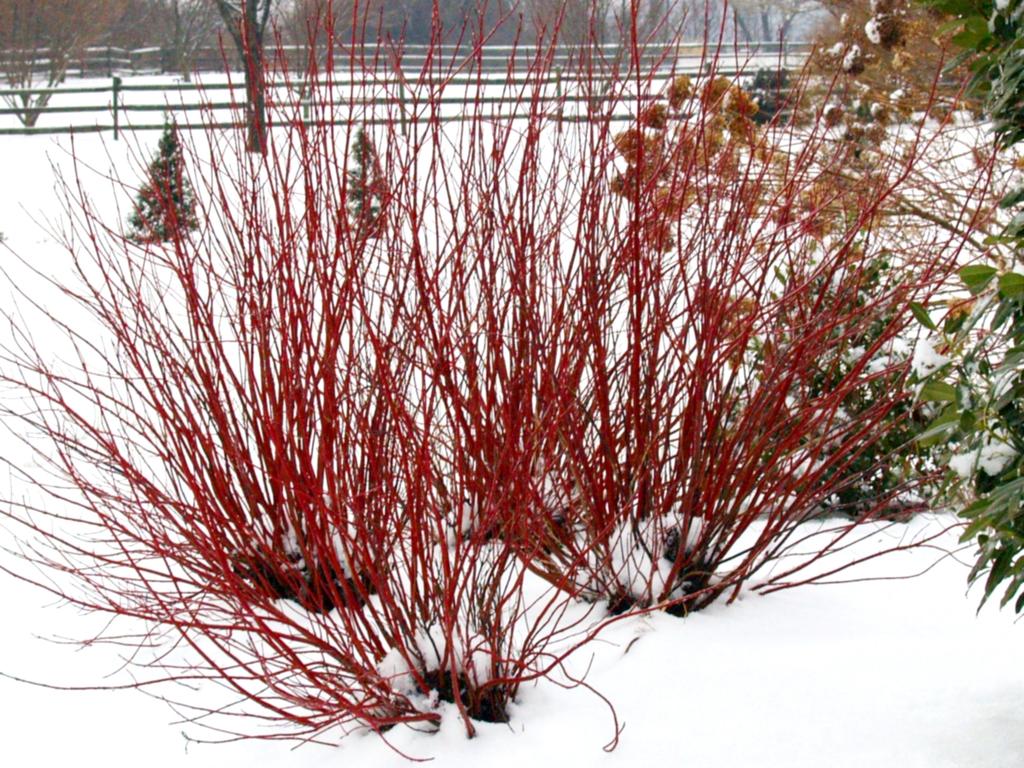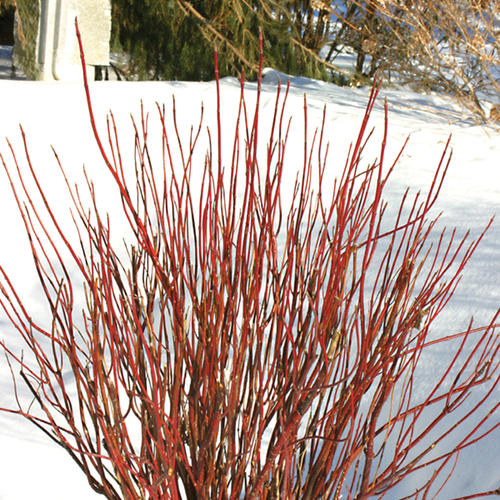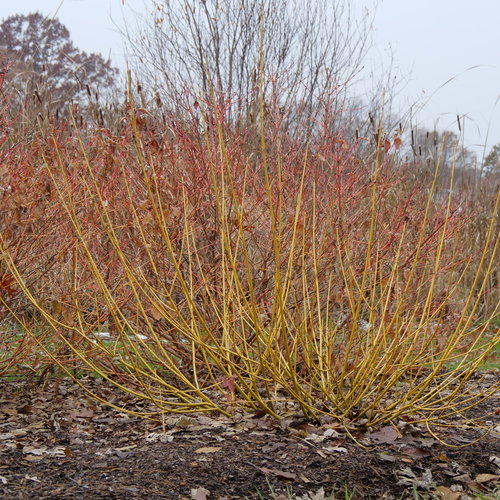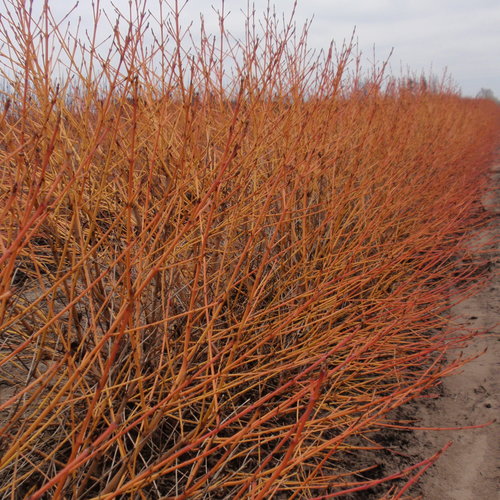Red Twig Dogwood - The Ultimate Guide from Proven Winners®
Red twig dogwoods are easy-care deciduous shrubs that contribute color to the landscape in all four seasons.
 Buy red twig dogwoods – Order online and have them shipped right to your door
Buy red twig dogwoods – Order online and have them shipped right to your door
Red twig dogwood shrub is most commonly grown for the brightly colored branches that lend winter interest in the landscape. Unlike the more familiar tree dogwoods which develop a single or multi-stemmed trunk, this type of dogwood produces thin twiggy growth from the base that spreads to form dense clumps.
The upright branches come in colors of red, yellow, orange and coral, becoming more vivid during winter months after the leaves have dropped. Foliage is green, gold or variegated, with some varieties producing fall color. White flowers occurring in spring and summer are followed by white, blue or purple berries that provide food for songbirds and other wildlife. Use this versatile shrub in a woodland border, rain garden, massed along a slope, in containers and as hedging or screening.
RED TWIG DOGWOOD CARE & PLANTING
How to plant: When planting red twig dogwood shrubs, choose a site with full sun to partial shade and amended soil that drains well. Stem color is more vivid when planted in a site that gets at least 6 to 8 hours of direct sun. Follow these steps and space plants 2 to 15 feet apart, depending on the variety.
- Loosen soil in the planting area and dig a hole twice as wide and slightly deeper than the root ball.
- Remove the red twig dogwood from its nursery pot and gently tease out roots if potbound.
- Set the plant in the hole with the base slightly deeper than the surrounding soil.
- Backfill the hole with soil, tamp down slightly to remove air pockets, and water well. Keep plants watered regularly until established.
Soil: Red twig dogwood is tolerant of a wide range of soils including clay or rock. Plants will grow best in rich, well-draining soil with an acidic pH of 5.5 to 6.5. For containers, use a high-quality all-purpose potting mix.
Watering: Red twig dogwood is tolerant of wet soil and is somewhat drought tolerant once established. Provide supplemental water as needed during prolonged heat or dry spells.
Fertilizing: Plants need little or no supplemental fertilizer. If desired, spread a thin layer of compost around the base in early spring, or apply a slow-release fertilizer that is especially formulated for trees and shrubs.
Pruning: Newer stems produce the brightest color. When pruning red twig dogwood, remove up to a third of the oldest stems to stimulate new growth. As an alternative, or to rejuvenate older specimens, cut the entire plant back to the ground every two years. Remove dead or diseased growth as needed.
TRY THESE PROVEN WINNERS® VARIETIES
Red twig dogwood shrubs occur in different colors and sizes. Try these varieties in your landscape:
 Arctic Fire® Red Red-Osier Dogwood (Cornus stolonifera, syn. C. sericea) produces brilliant red stems which are at their best color in winter. The compact habit, just 3 to 5 feet tall and wide, is suitable for small spaces and containers. Arctic Fire® red twig dogwood is especially hardy in colder regions. The attractive branches can be cut for winter arrangements. Arctic Fire® Red Red-Osier Dogwood (Cornus stolonifera, syn. C. sericea) produces brilliant red stems which are at their best color in winter. The compact habit, just 3 to 5 feet tall and wide, is suitable for small spaces and containers. Arctic Fire® red twig dogwood is especially hardy in colder regions. The attractive branches can be cut for winter arrangements. |
 Arctic Fire® Yellow Red-Osier Dogwood (Cornus stolonifera, syn. C. sericea) has bright yellow stems that light up the landscape during the dark days of winter. Plant this medium-sized variety alongside Arctic Fire® Red dogwood for eye-catching contrast. Use as screening, plant along a pond or stream, or naturalize in a woodland setting. Arctic Fire® Yellow Red-Osier Dogwood (Cornus stolonifera, syn. C. sericea) has bright yellow stems that light up the landscape during the dark days of winter. Plant this medium-sized variety alongside Arctic Fire® Red dogwood for eye-catching contrast. Use as screening, plant along a pond or stream, or naturalize in a woodland setting. |
 Arctic Sun® Bloodtwig Dogwood (Cornus sanguinea) has uniquely colored stems that occur in warm hues of coral, orange and yellow for a dazzling effect in the landscape. The attractive green foliage, white flowers and berries provide color during the rest of the year. Use this medium-sized shrub as hedging or screening.
|
RED TWIG DOGWOOD FAQ’s
When to prune red twig dogwood?
Pruning is best done in early spring before the leaves emerge and it’s easier to see the plant structure.
How big do red twig dogwoods get?
Size varies according to the variety. Dwarf forms can reach just 2 feet tall and wide, while the largest varieties can be up to 15 feet tall and wide.
Does red twig dogwood spread?
Red twig dogwood spreads through suckering roots to form a dense clump. To control spread, use a sharp-edged shovel to cut back roots around the outer base of the plant.
Where does red twig dogwood grow best?
Red twig dogwood bush is tolerant of a wide range of growing conditions, including wet or poor soil, drought and shade. Red-osier dogwood (Cornus sericea), which is native to North America, occurs naturally in wet areas such as bogs and wetlands. Grow red twig dogwood along a stream or pond, in a rain garden, or woodland setting.
Is red twig dogwood fast-growing?
This suckering shrub can spread rapidly, up to 2 feet in a single growing season.
Is red twig dogwood easy to care for?
This easy-care shrub is forgiving of many different growing conditions. All that’s needed is pruning in early spring, along with light fertilization if desired.
What should red twig dogwood be grown alongside?
Grow red twig dogwoods with other plants that thrive in similar growing conditions, such as Joe-Pye weed, pussy willow (Salix), winterberry (Ilex verticillata), asters, maiden grass (Miscanthus sinensis), azaleas and rhododendrons.
Are red twig dogwood deer resistant?
In most cases, deer will not bother red twig dogwoods, though some grazing can occur if other food sources are scarce.
Red twig vs yellow twig dogwood
There are some varieties of red twig dogwood that produce yellow stems, such as Arctic Fire® Yellow, which is a common or red-osier dogwood.
RED TWIG DOGWOOD LANDSCAPE DESIGN IDEAS
With four-season appeal and adaptability to a wide range of growing conditions, there are many ways to use red twig dogwood shrub in your landscape.
- Mass along a slope or flood-prone stream bank to help stem erosion.
- Plant a red twig dogwood hedge as screening along a property line.
- Grow in a low area where water collects in combination with other water-loving plants as part of a rain garden.
- Cut the decorative colored stems to use in winter arrangements and holiday displays. See more shrubs for cut branches.
- Combine varieties with different colored stems for a compelling effect in the winter landscape.
- Plant smaller specimens of red twig dogwood in pots alongside other plants with winter interest such as hellebores, cyclamen and holly. Display the pots near your home’s entryway where they can be regularly enjoyed.
- Create a winter garden featuring red twig dogwood and other plants with winter interest such as witch hazel, hellebores, winter heath, honeysuckle and bulbs such as cyclamen and snowdrops.
- Site plants where the low angle of the winter sun can highlight the colored stems.
RED TWIG DOGWOOD COMPANION PLANTS
Red twig dogwood provides food and shelter for songbirds and other wildlife and performs well in many different settings. Combine with other plants with similar cultural needs of full sun to partial shade and tolerance of wet soil.
For a woodland garden, plant alongside:
- Interstella® Lily of the Valley shrub
- ‘Vision in Red’ Chinese astilbe
- Golden Shadows® pagoda dogwood
- Bobo® panicle hydrangea
For a wildlife-friendly landscape, plant with:
For a rain garden or other wet area, such as along a stream or pond, combine with:
- ‘Bottle Rocket’ ligularia
- Summerific® ‘Berry Awesome’ rose mallow
- Prairie Winds® ‘Lemon Squeeze’ fountain grass
- Rainbow Rhythm® ‘Ruby Spider’ daylily




